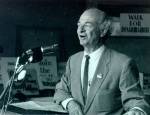|
Hemoglobin, sickle cell anemia, and molecular diseases remained pursuits of Pauling's
for the rest of his life even though his interests diversified in the second half
of the twentieth century. Especially pivotal was the decade from 1945 to 1954, which
shaped a number of projects that Pauling embarked on over the next forty years. Also,
winning the Nobel Prize in Chemistry in 1954 significantly affected Pauling's career
path because afterwards he devoted more time to peace work.
Indeed, Pauling divided his time more evenly between chemistry and peace after 1954.
Yet, he also intertwined these two areas by using his expertise in chemistry to speak
against war and the development of nuclear weapons. However, he did not limit his
political and social statements to peace issues, but rather introduced such statements
during some of the scientific lectures he gave after mid-century.
The next section focuses on Pauling's diverse uses of hemoglobin, sickle cell anemia,
and his concept of molecular disease. Common to most of Pauling's interests during
this time period was his desire to alleviate human suffering.
|
|
Click images to enlarge

Linus Pauling speaking at a rally for disarmament, Exposition Park, Los Angeles, California. 1960.

"A Sane Nuclear Policy." June 16, 1960.
"Hemoglobin is complicated enough to be interesting. I began research in the nature
of hemoglobin in 1935, and now 31 years later, I am still entranced by this wonderful
molecule."
|

